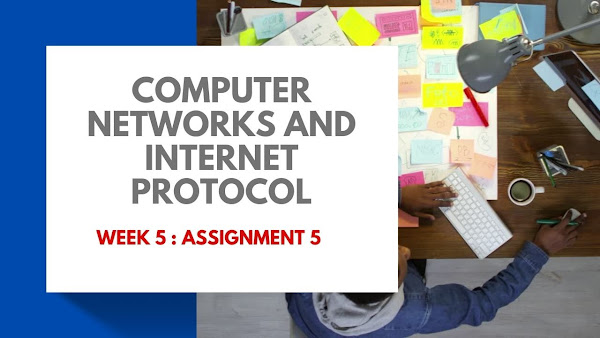Computer Networks And Internet Protocol - Week 5 | Assignment 5 : Answer with Explanation
Which of the following is true?
a. UDP uses congestion controlb. UDP uses both flow control and congestion control
c. UDP uses flow control
d. UDP doesn't have any flow control, congestion control
Answer
d. UDP doesn't have any flow control, congestion control
No flow control, no congestion
control
SOCK STREAM represents
a. UDP-based Datagram Socketb. TCP-based Stream Socket
c. QUIC-based Stream Socket
d. None of the above
Answer
b. TCP-based Stream Socket
Stream Socket (SOCK STREAM): Reliable, connection oriented
(TCP based)
FD_ZERO is used for
a. tests to see if a file descriptor is part of the setb. Initializes the file descriptor set fd_set — a bitmap of fixed size
c. Set a file descriptor as a part of a fd_set
d. None
Answer
b. Initializes the file descriptor set fd_set — a bitmap of fixed size
FD_ZERO: Initializes the file descriptor set fd_set – a bitmap of fixed size
Which statement (s) is/are true for Slow Start
a. It leads to slow convergence of the Congestion windowb. The rate of increase in the congestion window is very slow
c. It increases the congestion window exponentially to reach faster convergence
d. It slows down the 3-way handshaking process
Answer
b. The rate of increase in the congestion window is very slow
Sender Window in TCP can be given as:
a. Sender Window = max(Congestion Window, Receiver Window) Congestion Windowb. Sender Window = Congestion Window
c. Sender Window = Receiver Window
d. Sender Window = min(Congestion Window, Receiver Window)
Answer
d. Sender Window = min(Congestion Window, Receiver Window)
Socket Address is:
a. Ipv4 Address Translated to Ipv6 Addressb. Combination of IP Address and Port Address
c. Combination of MAC Address and domain Address
d. Application Layer Address
Answer
b. Combination of IP Address and Port Address
In computer networking, a socket address is a combination of an IP address and a port number that uniquely identifies a particular network service on a host. It is used by the Transport Layer protocols, such as TCP and UDP, to establish a connection between two endpoints on a network.
The IP address identifies the host where the service is running, while the port number identifies the specific service or application running on that host. For example, the socket address "192.168.1.100:80" specifies that the service running on the host with IP address 192.168.1.100 is listening on port number 80, which is typically used for HTTP traffic.
Socket addresses are important for establishing network connections, as they provide a way for applications to communicate with each other over the network. They are typically represented as a string in the format "IP address:port number", and can be used by both client and server applications to establish a connection and exchange data.
Which of the following uses UDP?
a. DNSb. POP
c. HTTP
d. FTP
Answer
a. DNS
DNS (Domain Name System) uses UDP (User Datagram Protocol) as its transport protocol. UDP is a simple, connectionless protocol that doesn't provide error checking or reliability, but is well-suited for applications like DNS that require low latency and fast transmission of small packets.
When you create a socket as s = socket(domain, type, protocol), why do you set the value of the protocol parameter as zero?
a. The system selects the default protocol number for the domain and socket type requestedb. No protocol needed
c. Since a computer understands binary so that it can be either 0 or 1
d. None.
Answer
a. The system selects the default protocol number for the domain and socket type
requested
When creating a socket using the socket() function, the protocol parameter specifies the protocol to be used by the socket. However, for most applications, it is not necessary to specify a particular protocol, and the operating system can choose an appropriate protocol based on the specified domain and socket type.
select() system call returns zero when?
a. Means an error was encounteredb. This means the call timed out without any event ready for the sockets monitored
c. Zero Is the number of sockets that have events pending (read, write, exception)
d.OS kills the process.
Answer
b. This means the call timed out without any event ready for the sockets monitored
-1: Means an error was encountered, you should do something about it. I just print
the error
0: Means the call timed out without any event ready for the sockets monitored
>0: Is the number of sockets that have events pending (read, write, exception)
In TCP congestion control mechanism is triggered once
a. 1 Duplicate ACK(DUPACK) is receivedb. After a Retransmission Timeout(RTO)
c. 3 Duplicate ACK(DUPACK) is received
d. No Duplicate ACK(DUPACK) is received
Answer
b. After a Retransmission Timeout(RTO)
c. 3 Duplicate ACK(DUPACK) is received
Two ways to trigger a congestion notification in TCP – (1) RTO, (2) Duplicate ACK.
THREE duplicate ACKs (DUPACKs) imply that a
packet has been lost – triggers congestion control mechanism
Disclaimer:
"This page contains multiple choice questions (MCQs) related to Computer Networks and Internet Protocols. The answers to these questions are provided for educational and informational purposes only.These answers are provided only for the purpose to help students to take references. This website does not claim any surety of 100% correct answers. So, this website urges you to complete your assignment yourself."




0 Comments